Readers may remember the December 2, 2018 column titled Lenox Youth’s arrow drops after-school buck. The article was about 17-year old Richard (Ricky) Armstrong and how he dropped a 10-point, 215lbs buck while archery hunting on November 19.
Well, on December 24, his 13-year old brother Brendan, while hunting with his father Richard, brother Ricky and uncle Harold Armstrong, dropped the pictured 8-point 190lbs buck, using a muzzleloader firearm. His older brother Ricky drove the deer into them and Brendan made a 100-yard shot.
“It was kind of crazy”, said Brendan, “The deer came running like wicked fast but my dad yelled at it three times and got it to stop and I put the scope on it. When I shot, I couldn’t tell if I hit it real good.” (The smoke from the black powder blocked his view). “It ran, and we couldn’t really see it. When we found it, it had only run about 75 yards. I was shocked!”. 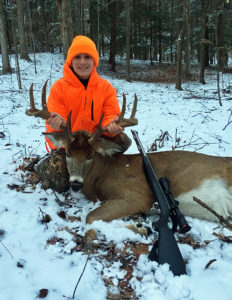
His dad had previously told him if his brother Ricky pushes anything good into him, make sure to put the crosshairs on its chest. That’s just what Brendan did. Brendan’s dad said that it was a 100-yard shot and he couldn’t have hit it any better. It went about 60-75 yards after being hit.” There was some snow and they trailed it and found it about 75 yards away. It was a long drag, but Uncle Harold caught up with them and helped drag it out of the woods. The couple of inches of snow really helped them drag it out.
You weren’t shaking or anything were you? I asked him. “I really didn’t have time to shake”, he said, “it came so fast that I was kind of ready. After I shot it, I was shaking a little.” The antler “green score” was roughly around 136 or 137 inches, a little less than young Ricky’s 167 3/8inch score. They intend to get that deer mounted also, just like Ricky is having his mounted. Brendan and I discussed how cool it will be to have two large mounted deer heads on the wall. I asked him if he had a nice den wall to put them in and he said that they will be hung on the wall on each side of the TV.
Brendan took the hunter safety course and at age 13 could hunt with the close supervision of his father. Only one gun between them can be used. Richard made note of the fact that his sons worked hard to get these deer. “They just didn’t walk down the road and choose one”, he said.
Sensing a serious outflow of cash, Brendan’s mom, Pam, asked her hubby, “Do we have to have this one mounted, too?” Actually, the deer has such a beautiful rack it looks like it came out of a magazine. They really should get it mounted. Rick feels that February and March will be costly months, when he gets the bills for mounting those deer. (Will they also need a larger freezer?) While Richard and I were discussing the deer, we both agreed that these two deer were bigger than anything either one of us ever shot in our lifetimes, and here these youngsters getting deer like that, especially Brendan getting his in his first year of hunting.
But wait, there’s more! In between the two huge bucks that Ricky and Brendan got, Nathan, the 16-year old brother, dropped a nice spike horn buck. Even though it was shotgun season, Nathan opted to use his muzzleloader firearm. All three deer were taken at undisclosed areas in Lenox. It may be the smaller of the three deer, but the venison from his buck will probably be the most tender. 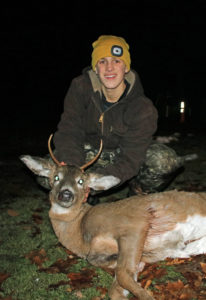
So how about that? Have you ever heard of 3 sibling teenagers taking three bucks during one year’s hunting seasons? I haven’t. This is quite a testament of the skills taught to the youngsters by their dad. He must be so, so proud of his three sons.
In my previous article about the Armstrongs, I mentioned that Ricky (and now Nathan and Brendan) are fourth generation deer hunters, following in the footsteps of their great grandfather, Richard, their grandfather Ricky and great uncle Billy, their father Richard and uncle Harold. Dare I suggest that they are a deer hunting dynasty?
Lest anyone think otherwise, deer hunting is not just a man’s sport any more. Some 19 women participated in the 2018 MassWildlife’s Becoming an Outdoors Woman Deer Hunt during shotgun deer hunting season. As noted on the MassWildlife facebook page, everyone had a great day in the field, especially the mother-daughter duo of Martha Hill and Liann Graf pictured herein. 
Deer hunting seasons are over
Deer hunting in Massachusetts ended on December 31, 2018. It will be a while before all of the harvest figures are accumulated and reported, but, if you followed this column during the season, you already know that some large, older deer have been taken.
The only game hunting seasons still open are cottontail rabbit and snowshoe hare hunting seasons which end on February 28, 2019. The furbearer hunting seasons end as follows: bobcat, coyote and fox on March 8; opossum and raccoon on January 31.
Wildlife Grants
The Baker-Polito Administration recently awarded over $300,000 to municipalities and organizations across the state for projects to improve wildlife habitat. The grants were provided through the Massachusetts Department of Fish and Game’s (DFG) Division of Fisheries and Wildlife’s (MassWildlife) Habitat Management Grant Program.
“Active habitat management is vitally important for many forms of wildlife, including birds, mammals, reptiles, and amphibians that often need less common habitats,” said DFG Commissioner Ron Amidon. “These grants will enhance habitat on municipal and privately-owned conservation land, and also improve recreational opportunities for sportsmen and women, birders, and other outdoor enthusiasts.”
Twelve wildlife habitat improvement projects, totaling 307 acres, will be funded. Western Massachusetts will receive 6 such grants as follows:
• Great Barrington – The Nature Conservancy has been awarded $39,325 to create and improve old field and shrubland habitats at the Schenob Brook Preserve.
• Lenox – The Berkshire Natural Resources Council will receive $34,100 to remove the invasive hardy kiwi plant at Parson Marsh Reserve.
• Plainfield – The Franklin Land Trust has been awarded $32,228 to increase young forest cover on Guyette Farm.
• South Lee – South Lee Associates will receive $12,350 to control invasive species on Housatonic River properties.
• Sheffield – The Sheffield Land Trust has been awarded $17,290 to improve the Ashley Falls Woods riparian corridor by conducting invasive species removal.
• Stockbridge – The Laurel Hill Association has been awarded $25,800 to treat invasive species at the Four Corners – Larrywaug Brook property.
“Preserving wildlife habitat and open spaces is vital to our environmental stewardship in the Commonwealth,” said State Senator Adam G. Hinds. “I am grateful these awards will sustain partnerships and projects across my district and will help residents and visitors in Great Barrington, Lee, Lenox, Plainfield, Sheffield and Stockbridge to enjoy these natural resources for generations to come.”
“Berkshire County is known for its accessibility to nature and the outdoors” said State Representative William “Smitty” Pignatelli. “My district is home to a great number of sportsmen, fishermen, and hikers just to name a few, and the Habitat Management Grant Program allows locals and visitors to enjoy the outdoors while helping communities promote the wellbeing of local wildlife. As Dean of the Berkshire delegation and House Chairman of the Joint Committee on the Environment, Natural Resources and Agriculture, I’m very grateful to the Baker-Polito Administration and (Energy and Environmental Affairs) Secretary Matt Beaton for recognizing the responsibility we have to protect our natural habitats by making this funding available to our towns.”
Category Archives: Conservation
More than 1,300 acres of Western District lands protected by MassWildlife in f/y 2018
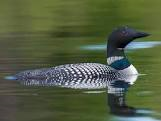
In his October report to the Berkshire County League of Sportsmen, DFW Western District Supervisor Andrew Madden announced that MassWildlife completed 14 land protection projects totaling more than 1,300 acres in the Western District in Fiscal Year 2018. Lands were protected for wildlife habitat as well as for hunting, fishing, and wildlife dependent recreation.
Local DFW Land Agent Peter Milanesi had a busy and productive year. Some of the projects he worked on had been previously noted in this column earlier this year, such as the 57 acres in Otis, 170 acres in the Hinsdale/Peru area and 232 acres in Hancock.
In West Stockbridge, two parcels of land were acquired. One was 15 acres named the Maple Hill Wildlife Management Area (WMA). This was a gift by the Pachas family and consisted mainly of land along the Williams River, which is stocked annually by the DFW. The Berkshire Natural Resources Council was instrumental in helping DFW acquire the property by removing an old building on the property. At this time, there is no public access to the property but hopefully, sometime in the future public access can be acquired. It protects a section of river behind the Ida Lane area, downstream of downtown West Stockbridge
The second piece in West Stockbridge was a 2.5 acre which abuts the Maple Hill WMA
In Egremont, working with NRD Funds and with the help of the BNRC (removed another building) some 59 acres were preserved. Part of the Jug End Fen WMA, access is off of Route 23. Karner Brook flows through part of the land.
Two pieces of land totaling approximately 7+ acres along Notch Road in Cheshire were acquired. They abut the Chalet WMA.
DFW acquired a Conservation Easement on 26+ acres near the Plainfield/Cummington town lines thanks to a donation by the Franklin Land Trust.
Another piece of Plainfield property where DFW acquired a Conservation Easement was some 99.66 acres of land formerly known as the Guyette Farm. Once again, the Franklin Land Trust donated the easement. Situated on Gloyd and South Central Roads and named the Meadow Brook Wildlife Conservation Easement, it has full public access.
Also, working with the Franklin Land Trust and using Landscape Partnership monies some 466 acres of land in the Plainfield, Cummington and Ashfield areas were protected. The North Branch of the Swift River which flows through the land is not stocked, but it has a population of wild, native trout.
Incidentally, on November 3, from 10am to 12pm, the Franklin Land Trust will celebrate this newly conserved Swift River Wildlife Management Area at the Plainfield Town Hall, Plainfield, MA. It is free and open to the public.
Hear from Mass Wildlife’s John Scanlon and Brian Hawthorne about the role this important piece of land plays in the broader landscape and the special habitat found there. An optional walking tour of Swift River WMA will follow. Light refreshments will be served. Call 413-625-9151 to reserve your space.
About 87 acres of land was preserved in Worthington. Access off of West Street but there is no formal parking area. It is now part of the Fox Den WMA.
Lastly, a 102.73- acre parcel of land was purchased in South Lee along the Housatonic River behind the old Country Curtains, on both sides of the river. The access points are through the Windsock Industrial Park near the cul-de-sac on the western side, and on the eastern side from Meadow Street which connects with the existing Hop Brook WMA. The Housatonic River, which runs through this property is a premier trout Catch and Release area.
All new land has been added to the MassWildlife Land Viewer system and can be viewed at www.mass.gov\masswildlife.
Loon project showing signs of success
After 4 or 5 years of dragging a loon raft out onto Cleveland Reservoir, DFW Supervisor Madden reported that they had their first successful nesting pair of loons in Berkshire County. They were able to band the adults and the young ones.
They actually built the loon raft and “It was nice to have it actually work”, said Madden. They are now looking at some additional sites.
There is a program in the eastern part of the state where DFW got some loons from up in Maine and brought them down as chicks and put them out in the wild and they also are getting returns.
If there is a sound that epitomizes the remote northern lakes and ponds it is the call of the loon, especially during the quiet twilight hours. It truly is a call of the wild. Once you have heard its call, you will never forget it. Rarely will you hear its call from close proximity for it is a shy, elusive bird. If you hear one at all, it will usually be from a great distance.
An important part of my trips to northern Maine, and eastern Canada is hearing the sound of these birds echoing across the undisturbed, remote ponds in or near God’s country.
Unfortunately, these magnificent birds are susceptible to picking up and digesting fishermen’s lead sinkers, presumably mistaking them for pebbles for their craw, and many have died from lead poison because of it. Some years ago, Massachusetts established regulations banning the use of lead sinkers and jigs under a certain size.
Although it was an inconvenience for the fishermen because they had to divest themselves of the lead sinkers and use other materials such as tin, bismuth, steel, and tungsten-nickel alloy. But, I believe the rewards of having the loons in our midst again makes it all worthwhile.
Incidentally, if you are unfamiliar with the sound of loons, just google “loons”, then “loonsong”, sit back and enjoy their music.
Pistol shooters
Remember my column of July 1, 2018 (State title for Lenox) where I mentioned that the Lenox Sportsmen’s Club Pistol Shooting team took first place at the State finals? According to Team Captain David Cimini, that could be the first State title ever for the club and perhaps for a Berkshire team, at least in recent memory.
They scored 4,126 out of 4,500 possible points, beating the 2nd place Merrimac Valley Pistol League by 21 points.
The Lenox team shooters were: Team Captain – David Cimini, Co-Captain Ray Scheufler, Peter Kirchner, Tom Greenleaf, Gregg Proctor and James Denault. All are Pittsfield residents except for Proctor who resides in Hinsdale. The top shooter was Denault who scored 834 out of 900 possible points.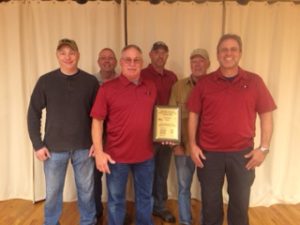
At that time, I mentioned that if I ever get a picture of these shooters holding their trophy I would run it. It took a while to get, but here it is. Congratulations gents! Might fine shooting!.
Fisheries & Wildlife Board Meeting
The October meeting of the Massachusetts Fisheries and Wildlife Board will be held this Tuesday, October 30, at 10:00 am at the Lenox Library, in the Welles Gallery, 18 Main Street, Lenox.
Drivers beware of amorous deer
Last weekend I bumped into old buddy Ken Kirchener on Ashmere Lake in Hinsdale When he saw me, he shouted over the boat engine noise, “I have a story for you”. He had witnessed an interesting event and wondered if readers would find it interesting, too.
On September 1 around 11:30 am, Ken was driving along the Skyline Trail in Hinsdale and on a manicured lawn, he spotted a doe walking along a hedge row. Right out of nowhere there appeared a spike-horn buck behind it. The doe crossed the road but the buck was leery, stopped and looked at Ken. The doe went back across the road to where the buck was standing. Then the doe crossed the road again and this time the buck followed her and stood in the middle of the road. Suddenly behind him there appeared another larger deer. That one was a 4-pt buck.
Then the spike-horned buck turned and the two bucks began fighting thrashing their hooves at one another while standing on their hind legs, right on the blacktop in the middle of the road. “It was just like a boxing match” said Ken. The doe was just standing there on the sideline watching.
The doe then moved into the brush and right behind her went the spike. The 4-pointer followed behind the spike. When a car approached Ken had to move, but when he was able to see the deer again, all three of them were just off the side of the road in some big tall golden rods. Both buck’s antlers were still in velvet.
I asked Ken who won the boxing match but Ken couldn’t tell. He doesn’t usually referee buck fights but he assumes that the spike won because he was the one immediately behind the doe when they went into the woods.
Could this be classified as road rage? Wouldn’t you think those bucks would settle such matters out behind the barn? And the audacity of that doe, is there no modesty left?
Seriously folks Massachusetts deer usually breed between late October and early December. Apparently, these deer were jumping the gun a little bit. During the rutting season, bucks are more active throughout the day than usual and they often chase does across roads without hesitation. MassWildlife urges drivers to be extra cautious and slow down during the fall.
Massachusetts Junior Conservation Camp
On August 17, the traditional outdoor-graduation ceremony of the Massachusetts Junior Conservation Camp (MJCC) in Russell, MA took place.
Since 1949, the MJCC has provided young people with a unique experience of conservation, shooting sports and outdoor recreation education. The 12-day program introduces girls and boys ages 13 to 17-years old to the ethical responsibilities of hunting and fishing in order to foster careful stewardship of natural resources, connections with natural resource professionals and opportunities to learn or enhance their outdoor skills.
During the Graduation Ceremony, awards for the Camp Competition Day were presented and congratulations were offered by Stephen Johnson, MJCC Board President, Ron Amidon, Department of Fish & Game Commissioner and Division of Fisheries and Wildlife (MassWildlife) Director Mark Tisa.
John Gaj of Blandford, MA took first place in archery. Assistant Instructor Jordan Peck of Peru was acknowledged for catching his first fish. Super campers were identified by camp staff for their outstanding leadership skills and compassion. One of the 2019 Super Campers was Kaela Martin of Sheffield.
“We greatly appreciate the support of our camp partners,” said Stephen Johnson, “We are especially grateful for the long-term commitment to Conservation Camp by MassWildlife, the Department of Conservation and Recreation (DCR), the Environmental Police and the Gun Owners Action League. He thanked Dick’s Sporting Goods, Cabela’s, and other sporting goods stores for donations of outdoor equipment for camper use. He also noted that 85% of campers’ tuitions were funded by generous individuals, local and regional sporting clubs and civic organizations. MassWildlife Director Mark Tisa, a past MJCC camper, told campers that his experience at camp years ago inspired him to pursue a career in fisheries.
Campers learn how to safely use firearms, archery, fishing, navigation and camping gear. State Hunter Education courses from MassWildlife and a Safe Boating course are taught by the Environmental Police. Shooting certification in several courses is also offered. Fish and wildlife biologists from MassWildlife and forestry professionals from DCR provide instruction in wildlife, forestry, and fisheries management. Fishing, hiking, outdoor cooking, navigating with GPS and compass, and survival skills learning are provided by experienced outdoor instructors.
Learn more by visiting www.juniorconservationcamp.org or the Camp Facebook page at https://www.facebook.com/Mass-Junior-Conservation-Camp-. The MJCC email is: MAJuniorCamp@gmail.com. The MJCC Board welcomes support for the Conservation Camp through tax-deductible donations.
Parsons Marsh
The Berkshire Natural Resources Council invites you to celebrate the opening of the new accessible trail at Parsons Marsh in Lenox next Saturday, September 15 from 9 am to noon. The event schedule is as follows: 9:00 am Bird Walk with well-known Berkshire birder Ed Neumuth, 10:00 am Music, Kid’s Crafts, 10:30am Ribbon Cutting 10:45 am Music, Cider Pressing, Kid’s Crafts, Explore the new trail. 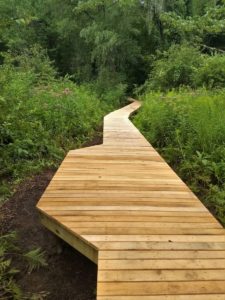
Parking is available at the Stonover Farm’s Event Parking Area, across from 169 Undermountain Rd, Lenox, MA 01240. Carpooling and walking are encouraged.
This is a cooperative trail project between Berkshire Natural Resources Council, the Town of Lenox through its Community Preservation Fund, and the Massachusetts Recreational Trails Program and was also supported by the Lenox Land Trust.
The MassWildlife Habitat Management Grant Program
This program provides financial assistance to private and municipal landowners of conserved lands to improve and manage habitat for game species and other Species of Greatest Conservation Need as identified in the State Wildlife Action Plan. The grant program also aims to expand opportunities for hunting, fishing, and other outdoor recreation, and complement ongoing habitat management work on state lands.
This year EEOEA Secretary Matthew Beaton provided MassWildlife with $300,000 to fund another year of this popular and effective program. Details on how to apply for the MassWildlife Habitat Management Grant can be found at mass.gov/dfw/habitat-grant. The application period is now open with a proposal deadline of October 17, 2018.
Last year, a team of reviewers selected 20 proposals submitted by municipalities, private citizens, and NGOs for projects in 19 towns and cities. The projects included invasive plant control, old field habitat improvement, prescribed fire to enhance habitats, stream restoration work, etc. Approximately 950 acres were successfully managed as a result of the funding.
There are some significant changes to the program this year, including an expansion of eligible lands, and the use of a fillable form for an application. This form application should make it easier for individuals and organizations that are not experienced in grant writing to be able to apply for this funding opportunity to conduct work on land they own or manage.
Turkey Shoots
The Lenox Sportsmen’s Club recently announced that it will be starting its fall turkey shoots on September 16 at 1:00 pm and will run every Sunday until November 18. Shooters are encouraged to bring their shotgun and 22 rifle or pistol to take a shot at winning Thanksgiving Dinner. For more info contact Lorenzo Marangoni: 413-822-7412.
Life Preservers
Don’t forget! From September 15 to May 15 Massachusetts regulations require that anyone using a canoe or kayak must wear a life preserver. Don’t sit on it, wear it!
Whip-poor-wills recovery and prescribed burning. Is there a connection?
During the Berkshire County League of Sportsmen meeting in May, 2018, Fish &Wildlife Board Member from the Western District Steve Sears reported that the Board had received a great presentation on whip-poor-will birds. They appear to be showing a very slight recovery in Massachusetts.
Whip-poor-wills, wow! I haven’t heard that bird since I was a youngster, probably in the 1940’s, when my father pointed out the call at dusk. According to MassWildlife, they pretty much disappeared from the Berkshires in the early 1970’s. Currently, there are only a few populations in Ma, mainly in the eastern part.
Until now, I had always assumed that the widespread use of DDT pretty much did them in, similar to what happened to the bald eagle, peregrine falcon and other birds. (DDT caused the birds to lay eggs with soft shells). DFW WD Supervisor Andrew Madden felt that there was more to it than DDT. If that was the main reason for their demise, then why aren’t they recovering quicker now that DDT is banned, like the raptors? He felt that it probably had more to do with their loss of habitat. He and Steve felt that possibly the prescribed burning that the Division is doing had something to do with their slow but gradual recovery.
They may be right. According to MassWildlife’s Natural Heritage Endangered Species Program biologists, whip-poor-wills seek dry, open woodlands with little understory adjacent to meadows and shrublands. The open woodlands are used for nesting and the adjacent meadows and shrublands are used for foraging. That probably explains why they were around my neighborhood back then as there were several 100+ acre farms. The cows probably kept the understory in the nearby woods down. Cows weren’t necessarily fenced out of those woods so that they could get into the shade on hot days.
According to MassWildlife, prescribed fire is an essential tool for managing wildlife habitats and natural communities throughout MA. Despite early spring rain and snow this year, they had a record season, burning over 415 acres!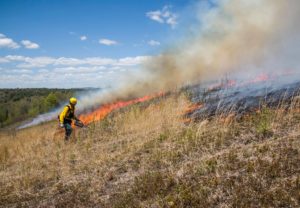
For many decades total fire exclusion from all natural lands was general policy throughout Massachusetts and the entire United States. But, fire exclusion has resulted in the decline of numerous species and degradation of entire ecosystems.
Historically, fire played a fundamental role in shaping certain portions of the Massachusetts landscape. In particular, glacial deposits of excessively well drained sand and gravel soils tend to be associated with relatively short fire intervals. These soil types occur primarily in coastal areas and in association with major river valleys. Lightning-caused fires and/or fires set by Native people in these areas historically maintained highly productive wildlife habitats including heath lands, pitch pine/scrub oak barrens, and open canopy oak-pine woodlands.
Decades of fire exclusion following European settlement resulted in the decline of numerous species and degradation of entire fire-associated ecosystems. In Massachusetts, some vegetation and habitats have evolved with fire and are best maintained with periodic burning, including some areas that are home to state and federally listed rare, endangered, or threatened species. Prescribed fire is used to restore and maintain these habitats.
The primary concerns for all prescribed burns involve human safety and protection of built infrastructure. Planning is critical for every burn. Fire behavior and weather are monitored throughout the burn, and if the prescription parameters are exceeded the fire is “shut down”. Permits are required from the town fire chief and the air quality staff at DEP’s regional offices. The local fire chief can of course stop the fire at any time. There is a public meeting in most areas before prescribed burning is introduced. Abutting landowners are notified of fire dates, reasons, and expectations
Approximately 30% of the MESA-listed (endangered) plant and animal species in Massachusetts benefit from the conditions created and maintained by fire. Natural Communities that benefit from prescribed burning include Sandplain Grassland, Sandplain Heathland, Scrub Oak Shrubland, Pitch pine-scrub oak, Ridgetop pitch pine-scrub oak, Calcareous fen, and Oak woodland.
In follow-up to last week’s Deerfield River article
MassWildlife has launched a project to study brown trout in the upper Deerfield River. This spring, all 1,000 hatchery-raised brown trout stocked in the upper Deerfield were marked by clipping their adipose fins. The adipose fin is a small fatty fin on the dorsal surface (back) of the trout. Research has shown that the removal of this fin is the least intrusive, detrimental, or painful compared to all other fins on the body, and this work is performed by trained biologists with a specific research need.
These marked fish were stocked in their usual locations from Buckland to the Fife Brook Dam. This is the first phase of the project that will eventually mark all hatchery-raised fish in that section of the river. Marking of hatchery fish, together with other elements of the Deerfield River Brown Trout Study, will continue for several years. Anglers should note that for the next few years, there may be holdover hatchery-raised browns in the system that have not been marked.
This project to learn more about both the hatchery-raised and wild brown trout populations took shape through a collaborative process involving MassWildlife and Trout Unlimited. It included input and assistance from a number of other interested parties and individuals from UMass Amherst, US Geological Survey, local Deerfield River fishing guides, and local watershed groups. The study will yield important population metrics including abundance, mortality, and growth rates of individual fish. MassWildlife will use this information to better manage the upper Deerfield River brown trout fishery.
So long Bill Byrne, thanks for the pictures
For over four decades, the spectacular photographs taken by MassWildlife Senior Photographer Bill Byrne have brought sportsmen and women and other conservationists up close and personal with countless wildlife species from across the Commonwealth. Bill’s stunning images ranging from breaching humpback whales, foraging black bears, and secretive piping plovers to urban peregrine falcons, majestic Quabbin moose, and elusive timber rattlesnakes. 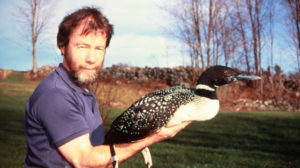
Sadly, Bill’s life ended suddenly and unexpectedly in May while spending his last moments doing what he loved: being outdoors, honing his skills as a photographer, and talking photography and wildlife with colleagues and friends.
He is best known for his striking images of bald eagles, moose, black bears, shorebirds, waterfowl, deer, wild turkeys, and many other species, thousands of which have appeared on the cover of Massachusetts Wildlife magazine and other agency publications
He will be missed.
Back home
With luck my wife Jan and I returned home yesterday after a couple of weeks cruising around the British Isles (Ireland, Scotland, and England) and Normandy. There is some good fishing for brown trout and Atlantic Salmon over there but we were on a cruise with a tight schedule and there was no time for fishing. Plus, the possibility of getting a permit to fish there was probably rare and expensive.
One day, we sailed on Loch Ness. I seriously thought about trolling a flatfish off the stern of the cruise ship and catching the fabled monster, Nessie, thus putting to rest once and for all the speculation as to whether or not it exists. But I didn’t have a large enough net, and they probably wouldn’t let me keep it to mount anyway.
Stream continuity is critical
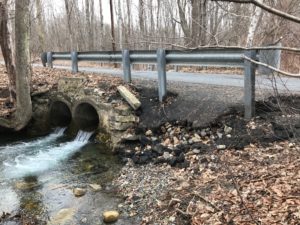
Especially to all creatures that depend on rivers and streams, including invertebrates, fish, amphibians, reptiles, and mammals. Experts say the design and condition of stream crossings determine whether a river behaves naturally and whether wildlife can migrate freely. Crossings should be essentially “invisible” to fish and wildlife—they should maintain appropriate flow and substrate through the crossing and not constrict a stream.
Through the combined effects of dams and poorly designed stream crossings (certain culverts and bridges), we have fragmented rivers and streams and hindered wildlife dispersal throughout our watersheds. In many cases, even crossings that were once effective are now barriers because of river erosion or mechanical breakdown. Safe and stable stream crossings can accommodate wildlife and protect stream health while reducing expensive erosion and structural damage.
That takes us to the Churchill Brook culvert which crosses Hancock Road in Pittsfield. (brook ultimately drains into Onota Lake). The pipes appear to have been improperly installed or developed erosion problems and acted like dams. They were elevated and made it difficult, if not impossible for trout to pass through. Fish had to jump in order to get into them and because they are pipes, and not a natural passway, they had to swim through stronger, concentrated currents to get to the other sides and continue their spawning run. Not only that, the culvert was falling apart.
The new culvert is much wider, with a natural stream bottom so that fish and other animals can easily pass through. A neighbor was really pleased with the improvement because during heavy rains, his lawn became completely flooded and his house became an island, due to the previous pipe being too small.
The Housatonic Valley Association (HVA), with help from the Berkshire Environmental Action Team (BEAT) decided to do something about that. They applied for, and received, grants from the Natural Resources Damages Program (NRD) and the Massachusetts Environmental Trust (MET).
There are two projects going on there. The NRD grant paid for the culvert project which allows the fish passage and the second project, a MET grant, paid to plant the rain gardens on both sides of the road. (Readers may recall in a previous article that funding for MET grants come from the sale of special license plates).
There are numerous brook trout all the way up the stream and until now they couldn’t swim upstream past the culverts. That is all changed now and the fish can pass through. Clayton Davenport Trucking, Inc. did the culvert replacement work.
There is one more culvert a little further upstream which crosses Churchill Road and HVA already has a grant to do that project as well. Hopefully in a couple of years, when that project is completed, it will open Churchill Brook from Onota Lake all the way up to Pittsfield State Forest, enabling brook trout to travel without obstructions.
Incidentally, MassWildlife has listed this brook as one of the best habitats for brook trout because there is ample food and cold, clean water.
Biologists caution us to not underestimate the effect of culvert crossings. While culverts only cover small sections of any stream, their influence on fish and other aquatic species can be immense, especially when you consider the cumulative effects of many road crossings. Proper planning, design, and installation can protect roads while providing year-round fish passage and preserving healthy streams.
Also, we should keep in mind that in situations where fish passage is not a major concern, other aquatic species of concern such as such as mink, frogs, turtles, insects, crayfish, snails, etc. may use the culvert and will need to rely on natural streambed sediments in the culvert to aid their movement. It has also been recognized for some time that juvenile fish are very active throughout the year, moving upstream and downstream in response to a number of environmental factors.
The Berkshires are not alone with culvert problems. In a 2009 survey of culverts in a nearby Appalachian watershed, some 120 state‐owned culverts were surveyed using a fish passage assessment filter to determine the “passability” of each culvert. The results showed that 97% of surveyed culverts were classified as obstacles or complete barriers to trout dispersal. Some 33% of brook trout reproductive habitat, was isolated by culverts. The results indicate that standard culvert designs placed in streams with slopes exceeding 5% consistently produce trout dispersal barriers.
Although no comprehensive inventory of the number of culverts on fish-bearing streams in the United States is available, there is an estimated 1.4 million stream-road crossings.
So why is it important for fish and other critters to be able to pass through these culverts? Well, according to Scott D. Jackson, Department of Natural Resources Conservation, University of Massachusetts, Amherst in a paper done in 2003 entitled Ecological Considerations in the Design of River and Stream Crossings, such movements maintain gene flow among populations, helping to maintain genetic health. They may also represent movements of surplus animals from one population to another, perhaps one that could not support itself on its own reproduction. This supplementation of failing populations from “source” populations is referred to as “the rescue effect.” Finally, areas of appropriate habitat that may be temporarily vacant due to local extinctions, can be re-colonized by individuals from populations nearby.
The new rain gardens prevent much of the run-off (containing oil, gasoline and pollutants) which comes off the road from washing right into the brook and negatively affecting the water quality. The HVA/BEAT team built a buffer area so the water that comes into the drainage ditch is pooled in a vegetative garden which is submerged. It settles and filters the runoff gradually into the ground and replenishes the groundwater before entering the brook.
The type of vegetation planted were: Joe Pye Weed, sweet pepperbush, chokecherries, red dozier dogwood, elderberry and winterberry, all wetland plants that can withstand being inundated in water for a while. According to Denis Regan. Berkshire Director of HVA, this is a 4 -year old project because they couldn’t do it until the new culvert was finished.
On the day, of my visit, volunteers were working hard in the 80+ degree heat planting the vegetation. Volunteers included Jane Winn, Executive Director of BEAT, Elizabeth Orenstein, Erin Whitman (HVA intern for the summer) Denis Regan. Berkshire Director of HVA, Alison Dixon, HVA Berkshire Outreach Manager, Jen Evans, (BEAT intern for the summer), Jeff Turner and Sharon Siter.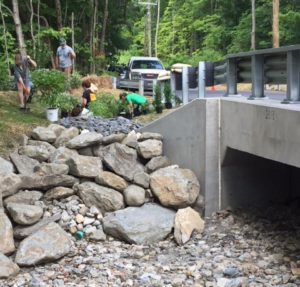
While I was there, Pittsfield Conservation Agent Robert Van der Kar and Pittsfield Staff Environmental Engineer Tim Croce dropped by to inspect the project to ensure compliance with storm water rules. Later on, Robert sent the following message to the HVA and BEAT volunteers: “On behalf of the folks here at City Hall, I just wanted to say how proud and grateful we are to have such a wonderful and dedicated group of people who continually improve the environment and quality of life (all life) here in the City of Pittsfield. You all truly make this a better place. Thank you all very much for all of your time and hard work in making what is an exemplary project; one that we’ll be sure to point to for years to come. Thank you.”
Local youth turkey hunting results were low, but enthusiasm was high
The special mentored youth turkey hunting day took place on Saturday, April 28. The combined turkey harvest for the Lee and Stockbridge Sportsmen’s clubs was only 4 birds. Its hard to figure out why as the weather wasn’t bad, the mentors are eminently qualified, the kids are decent shots and there appears to be a lot of turkeys strutting their stuff out there. Maybe the toms detected an accent in the turkey calls this year and became leery. Well, that’s the way it goes…..no excuses were offered.
This year, I covered the Lee Sportsmen’s Association which had 9 participants in the program and two birds were taken. Alex Navin, while hunting with mentor Doug LaPlante managed to bag a 15 lbs. bird around 6:00am with one clean shot to the head. They called in 5 or 6 other gobblers, too. He is very pleased with his new 20-gauge Mossberg Shotgun.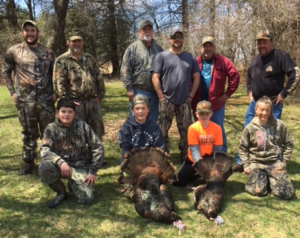
Daniel Epe, who was mentored by Mark Bartini, heard at least 6 toms all around them. The trouble was that some were in back yards and obviously he couldn’t go there to hunt them. He had one bird interested in Mark’s call, but he got busted (bird detected them and took off).
A similar situation occurred to Will Loring who was mentored by Isaac Winters. They had a bunch of gobblers nearby but couldn’t call them in. One bird had the nerve to strut nearby, but it got away. Matt Ranzoni was mentoring Will’s brother Charlie Loring and he bagged a 17 lbs. bird. No luck for Taylor Salice, who was mentored by Josh Hurlihey, but she had a good time hunting never-the-less.
John Ranzoni mentored Hunter Briggs, and he took a shot but didn’t drop the bird.
After having a burger or two excellently prepared by Tom and Virginia Dubois, the youngsters learned how to dress out the birds. In addition to the meat, they were shown how to save the tail feathers, beards, spurs, other feathers, etc.
Meanwhile, the folks at the Stockbridge Sportsmen’s Club also bagged two birds. Some 18 youths went out turkey hunting this year. Thanks to information provided by spokesman Mike Buffoni, here is how they did:
Two youths got birds and Mike reported that at least 3 other youths had shots but missed. Every kid had great action and heard birds gobbling. Colby Carlson (Mike’s nephew) who was mentored by Brian Korte went on his first hunt ever and got a jake. Brady Donald also got a nice bird. Pretty sure it was his first also. “Very cool to see the excitement in these youth hunters” said Mike.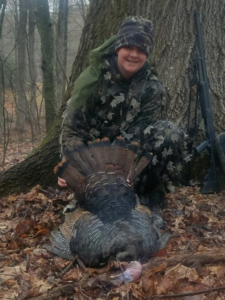
As usual they had a really nice lunch put on by Chef Peter Delgrande at the club. After eating, they also learned how to tend to the birds. Quite a few of the kids didn’t come for lunch and most were in shorts so they didn’t get a group photo this year. We did get a picture of young Colby Carlson with his turkey. The expression of joy and pride says it all, hey?
Few details came from North County except that Scott Krzanik of Adams, MA was mentoring his daughter Grace when she bagged an 18-pound bird with a 9 inch beard and 3/4″ spurs. She did this at 6:35 a.m. I believe I interviewed her back in 2016 when she got her first bird on youth day as well. Scott said that Matthew Tassone also got a nice tom North county.
According to Astrid Huseby, DFW Youth Turkey Hunt Coordinator, they don’t have exact numbers of how many youths participated. They do know that 270 youth ages 12-17 obtained the required permits/authorizations to hunt on the youth day, but not how many of those 270 actually went out hunting.
As for how many turkeys were harvested, they have a preliminary number of 52 birds reported online. More birds may have been harvested and taken to a check station that doesn’t use online reporting so they won’t have total numbers until the end of the season when all harvest reports are collected from check stations.
Free Fishing Days
In order to plan your fishing trips, here is a listing of free fishing days, where no freshwater license is needed: In Massachusetts, the dates are June 2 and 3. (You can also take advantage of free saltwater fishing on Father’s Day weekend – June 16 and 17). While you can fish for free on June 2-3, a license is required at all other times if you’re 15 or older. If you’re aged 15-17, your license is free.
In New York the free fishing days are June 23-24. They also have two additional free fishing dates in 2018 which are September 22 and November 11. In Vermont it is June 9. (Be sure to verify that date as I am receiving conflicting dates for Vermont). In New Hampshire the day is June 2; in Maine, the dates are June 2 and 3; the Connecticut Free Fishing date is May 12 and in Rhode Island they are May 6 and May 7. Now’s your chance to “test the waters” in our neighboring states free.
Pistol Shoots
The Cheshire Rod & Gun Club, 310 Curran Rd., Cheshire, MA, will be having outdoor pistol shoots this year. The monthly shoots take place on Saturdays starting at 10:00 am. The entry fee for the first shoot is $10.00 and $5.00 for the second shoot. The winners will split ½ the first shoot take and all of the second shoot take. On May 12, there will be “Wood Blocks Standin’ on a Log” centerfire. 5 shots at 5 blocks at 10, 15, 20 and 25 yards.
Rules: For Rimfire – .22 Caliber, Semi-Automatic Pistols or Revolvers. For Centerfire – Semi-Automatic Pistols or Revolvers, no caliber over .45, red dot scopes are allowed, 1 or 2- handed allowed.
Also, on Sunday, May 20, they will be having a Steel Action Shoot, and on Thursday, May 24 they will be having their first Thursday Night Steel Match.
For more information contact: Martha Lee (413) 212-4154, Evelyn Jones (413) 684-3391.
Trout Stocking
The following waters were scheduled to be stocked with trout last week: Hoosic River in Adams. Cheshire and Clarksburg; Greenwater Pond in Becket, West Branch of the Westfield River in Becket, Chester, Huntington and Middlefield; Westfield River Mainstem in Russell, Potash Brook in Blandford and Russell, Deerfield River in Buckland, Charlemont and Florida; Hudson Brook in Clarksburg, Pontoosuc Lake in Lanesborough and Big Pond in Otis.
Fishing Derby
The Berkshire Hatchery Foundation in Hartsville-New Marlborough is having its next free children’s fishing derby next Saturday, May 12, from 9 to 10:30 am at its lower pond. Children aged 12 and under must be accompanied by an adult.
Bass Fishing Tournament
The bass fishermen have started their 2018 tournaments and the first event was at the Congamond Lakes in Southwick, MA on April 29. The results are as follows: 1st place went to Ricky Terzak with 16.4 lbs. of bass. In 2nd place was Paul Procopio with 12.13 lbs. Dave Benham took 3rd with 12.4lbs, 4th place went to Bill Gates with 11 lbs. and in 5th place was Bill Pigott with 8.7 lbs. These are 5 fish totals weights. All were caught, weighed in and released.
The lunker (largemouth) bass was taken by Bill Gates, one weighing 4.1 lbs. Paul Procopio caught a 3.3 lbs. smallmouth. Both are currently leading in the Lunker of the Year contests.
Registration is open for the next tournament which takes place on May 13.
HVA to conduct Stream Assessments of the Konkapot and Williams Rivers
The Housatonic Valley Association (HVA) invites interested individuals to help form “Stream Teams” to complete Stream Assessments this spring and summer. “Stream Team” volunteers will walk, sometimes in the river, or paddle along an assigned segment of the river and record information along the way. All of the information collected will be compiled into a final Stream Assessment Report which will include conditions and use of the river sections plus possible recommendations for future projects. Assessments are to be completed from May to July and can be scheduled according to the volunteers’ availability.
HVA has scheduled a Stream Assessment volunteer training on Tuesday, May 15 from 5 to7pm in the Community Room of the Mason Library, Great Barrington. Registration is required, space is limited. They will also conduct an on-stream training practice review with date and time to be determined.
These surveys help HVA assess the health of the river and work with the community to improve that part of the watershed. All of the information collected will be compiled into a final Stream Assessment Report which will include conditions and use of the river sections, plus possible recommendations for future projects. These reports should be available in October 2018 on HVA’s website (hvatoday.org). Copies of the report, both digital or hard copy can be requested.
Funding for the Stream Assessments is provided by The Berkshire Environmental Endowment Fund, a fund of the Berkshire Taconic Community Foundation. The Green River and Southwest Branch of the Housatonic River Stream Assessments were completed in 2017. Copies of these reports and other previous reports are available at hvatoday.org or you can call and request a copy. If you are interested in participating in this project, call HVA at 413-298-7024 or email Alison at adixon@hvatoday.org.
The two Stream Assessments that are to be completed this year are the Williams and Konkapot Rivers. Both of these rivers are tributaries of the Housatonic River. The Williams River flows south and southeast through West Stockbridge and Great Barrington where it joins the Housatonic River while the Konkapot River begins in Monterey and continues south through New Marlborough and, after a dip into Canaan, Connecticut, flows into the Housatonic River in Sheffield.
“Stream Teams” for each of the rivers will be made up of small groups of 2 – 3 volunteers and the teams are typically assigned a 1 – 2 mile section of the river. HVA will train “Stream Team” volunteers on how to conduct the survey, what information to record, and safety protocols. Volunteers will be asked to record things of note such as: pipes that are seen, invasive plants or wildlife observations, and general river conditions and usage. Following the surveys, the “Stream Team” volunteers will come together to share their findings and discuss suitable recommendations. The information gathered will be compiled into final Stream Assessment reports – one for each of the tributaries.
Not all “Stream Team” members need to be involved in conducting a survey. If you have an interest or expertise in either the Williams or Konkapot Rivers, HVA welcomes your input. Trainings are expected to be scheduled in May. Surveys will be completed from May – July weather and water levels permitting. The final reports, which are expected to be compiled in late summer, will be submitted to the local municipalities and state government and should also be available to the public by October 2018. The assessment will be placed on the HVA website along with their past reports. Feel free to check out these past reports to help understand more about this program. Contact HVA at 413-298-7024 for more information about volunteering for a “Stream Team.”
Fisheries and Wildlife Board Meeting
The May meeting of the Fisheries and Wildlife Board will be held on Wednesday, May 16 at 1:00 p.m. at the Stationery Factory ,63 Flansburg Avenue, Dalton, MA.
Five are honored at the Silvio O. Conte Memorial Banquet
The Cheshire Rod & Gun Club banquet hall was packed last Saturday night to celebrate the Silvio O. Conte Sportsmen’s Awards Banquet. Mark Jester, former President of the Berkshire County League of Sportsmen (BCLS) was the emcee for the evening. The accomplishments of all of the award recipients were listed in my March 18 column.”
In presenting the first award, the Outstanding Achievement Award, to Tom Tyning, Fish & Wildlife Board Member Stephen Sears said, “He has not only taught students but also teachers to help them teach our views about all the great things of Berkshire County.” The Outstanding Achievement Award plaque reads, “In recognition of your efforts to introduce thousands of people including many future sportsmen to the vast wonders of the outdoors.” In his acceptance of the award, Tom mentioned that his real start in this area was when he was a kid growing up in the Connecticut Valley. He discussed his education and future endeavors in the area. Radio telepathy was first being invented in the 1970s and he said that he was able to put a transmitter into a turtle for 2 years. He described that period as, “a very quiet and slow period” of his life.
Then Mark Jester said some very nice things about me before presenting me with the John Zuber Award. This award reads, “Presented in recognition of his unwavering dedication to introduce and perpetuate the ideals of sportsmen in Berkshire County”. This was quite an honor for me because I had a great respect for John and what he accomplished during his lifetime. I thanked the sportsmen, conservationists and the DFW for supporting and reading the Berkshire Woods and Waters column over the years. If it wasn’t for them providing news information and pictures, I wouldn’t be able to write it weekly. I thanked the Berkshire Eagle for keeping the column after my predecessor, Ted Giddings retired. Lastly, I thanked his wife Jan, my “in-house” editor who proofreads and keeps me pretty much out of trouble.
Mark then presented the Lifetime Achievement Award to George Wislocki, who retired from the Berkshire Natural Resources Council (BNRC) after many years. “The County League and the BNRC have had a great relationship over the years, we helped them and they helped us.” The Lifetime Achievement Award plaque reads, “Worked for over 50 years preserving open space, majestic ridge lines and vulnerable wetlands of Berkshire County.” George commented that he grew up in Eastern MA and loved the outdoors, and when he was 14 he attended a youth conservation camp here in the Berkshires. Later on, when he was older and worked for the BNRC, he linked up with George “Gige” Darey in preserving land.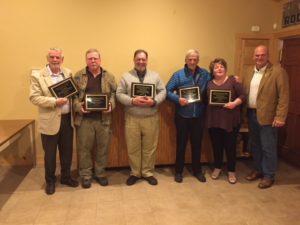
“I love these clubs (referring to the Cheshire Rod & Gun Clubhouse). “Look at everyone here”, these clubs are important but times are changing and I hope 50 years from today there will still be this club and there will still be people here”. He urged the sportsmen of Berkshire County to “take the kids into the woods and show them what the woods are all about. It’s an experience to be a sportsman, it’s a wonderful experience. It is so much Berkshire.”
“Its rare to have someone who is so dedicated to certain aspects of the outdoors and does so on a volunteer basis”, said Mark about Dan Miraglia when presenting him with the Sportsmen’s Appreciation Award. “He grew up fishing lakes and is really involved in the aquatic species. He is the eyes and ears when it comes to lakes, drawdowns and herbicide applications. He brings things to light for the sportsmen and keeps them involved in what is going on. He does so pretty much single handedly and the BCLS supports him, and he supports us. The “Sportsmen’s Appreciation Award plaque reads, “In recognition of his support dedication and oversight in the preservation of open space and wildlife”. Dan recalled as a kid catching gold fish and frogs in rivers and ponds and how the shores of Onota and Pontoosic Lakes were loaded with turtles and frogs. “Now they are disappearing in our lakes. There just is not enough protection”, he said. The effects of continued drawdowns for 30-40 years have had their effects. “Take the politics out of lake management and give our lakes back to the sportsmen”, he said.
Karen Kruszyna became the second woman to have ever be awarded the Sportsperson of the Year award. Only one other woman has won the award and that was Eleanor Tillinghast. “If you go to this club, (Cheshire), if you go to the Adams for Outdoor Youth Club, if you go to the BCLS functions, you will see Karen selling tickets”, said Jester. (she was selling tickets that night). She is always involved in the organizations’ activities and is there at the helm or standing behind the person speaking or running the event. Everyone knows that if it wasn’t for her, the person would not be able to put the event together. Same thing here tonight. Her Sportsperson of the Year plaque reads, “In recognition for her lifelong dedication, leadership and support of youth in Massachusetts.”
In accepting the award, Karen said that she is grateful every day because of the fact that when she has to do something she can always pick up the phone and ask for and always receive help. People almost never say no, and that’s why this all works. That very morning, she was so excited when she was driving through Adams and saw kids riding bikes with backpacks and fishing poles. She said, “Oh my god, kids going fishing”. She stopped and told them where she thought they would catch fish. “I learned this week that parts of the Archery-in-the School program is incorporated into a local school’s physics program. It’s wonderful to co-exist, when they learn about sports, they can also learn about other scientific things”.
Mark noted that the BCLS has its annual Youth Outreach Fishing Derby every year and that some twelve Berkshire County schools have Archery-in the School programs. If your school doesn’t have such a program and you want to see one, contact a BCLS delegate or Mark and they will work hard to get one in. They also have trout rearing and release programs in the schools,
“We are fighting a rear guard right now and we need to get these kids involved in the outdoors. Bring the kids to sportsmen’s dinners, turkey shoots, get them involved in archery and shooting programs.
Mark introduced current BCLS President Tom Brule to the crowd who in turn made some comments. Lastly, Mark thanked Mike Kruszyna, long time BCLS VP who filled in as president for the last 2 years until the position was filled by Tom.
Richmond Pond Trout Stocking
DFW had a special Earth Week trout stocking event on Richmond Pond on Friday, April 20. Leanda Fontaine-Gagnon, Aquatic Biologist for the DFW Western District (WD) explained that the purpose of the event was to get people familiar with their stocking process and what they do on a daily basis all year long. The WD covers all of Berkshire County as well as western portions of Hampshire, Hampton and Franklin Counties. DFW is charged with overseeing, protecting and managing the natural resources across the state. All 5 districts have the same type of staffing. In the WD, there is an Aquatic Biologist, a Wildlife Biologist, District Manager, four Wildlife Technicians, a Land Steward, who oversees all of their Wildlife Management Areas, a Real Estate Agent and a clerk.
They stock most of the locations in the spring and a handful in the fall. As Aquatic Biologist, she does all of the organization for the stocking in the WD. She determines what fish to stock and how many and what sizes to go in which waters. She puts in orders to the hatcheries for the fish and also goes out and stocks. During this time of year, she typically spends one day in the office and the rest of the week she is out in the field stocking.
Why do they stock fish? In this technologically advanced age, everybody is inside playing with smart phones, tablets and whatnot. DFW wants to get people back out into the world and enjoy what we have for natural resources; such as fishing, kayaking, and just enjoying the natural resources.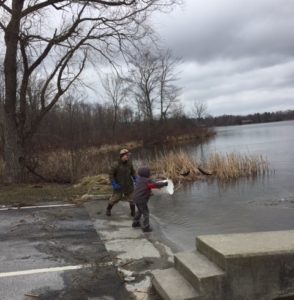
They are not stocking trout for restoration purposes but for people to catch. They are supplementing the wild trout populations for angling purposes in order to get pressure off of the wild trout population.
They stock four different types of trout in the state: brook, brown, rainbow, and a hybrid tiger trout which is a cross between a brook and brown. In the WD they stock just over 96,000 fish in the entire spring allotment and across the state it is about 600,000. Rainbow trout, 14 inches and over is the bulk of what they stock. They also put a lot of brookies, browns and tiger trout.
All of the trout come from 5 hatcheries across the state, with four in the Connecticut Valley: the Bitzer Fish Hatchery in Montague, Sunderland Fish Hatchery in Sunderland, McLaughlin Fish Hatchery in Belchertown and Roger Reed Hatchery in Palmer. Another hatchery, the Sandwich Fish Hatchery in Sandwich also produces tiger trout. The fish stocked at Richmond Pond on this day were from the McLaughlin Hatchery.
DFW put out a variety of fish from 9 to 18 inches. They stock out the fish based upon the size of the water body. Typically, they stock 12 plus inch fish in Richmond Pond but the 9-inch fish are usually stocked into smaller streams. They stock 70 cold water bodies in our district, 23 ponds and 54 rivers or streams.
On a typical day when they are stocking fish they check their schedules, drive to the hatchery, fill up with water there (they have 4 individual tanks in the truck) and obtain their allotted fish for that day. On this particular day, they were carrying 750 fish on board (about 1,000 lbs), with 350 of them going into Richmond Pond and the remainder to Goose Pond. When they arrive at their water bodies, they either send them out through chutes where they can do so or carry them by nets into rivers and streams.
It may seem like they are harming the fish by tossing them into the waters but if the fish are gently stocked, that is one of the worst things to do. The little plop into the water actually wakes them up a little. DFW takes care to ensure that the fish survive. (no casualties were observed this day).
After fielding a few questions, Leanda asked the 20 or so spectators to help out with the stocking process by carrying the trout in white 5 gallon pails to the lake front and tossing them into the water. Everyone, especially the kids, had a ball.
GOAL Seminar
On Tuesday, May 1, beginning at 6:30 pm, the Stockbridge Sportsmen’s Club will be hosting a free GOAL seminar entitled “MA Gun Law for Citizens”. It is a 3-hour seminar presented by Jon Green, Director of Education and Training for the Gun Owners Action League, that will help separate fact from fiction. Jon’s presentation will provide a clear understanding of Massachusetts gun laws and regulations.
All firearms owners should attend. The seminar is free to Berkshire County residents and neighboring counties courtesy of the Stockbridge Sportsmen’s Club. You are requested to RSVP so that they can plan seating for the event. Contact Robert J. McDermott at 413-232-7700 or robmcdermott@verizon.net or www.StockbridgeSportsmensClub.org.
Suggestions to avoid bear problems
According to DFW Western District Supervisor Andrew Madden, as of March 1, 2018 the Western District has had three reports of bears attacking livestock, in two cases killing a sheep and a goat. In the third case, a llama was attacked but got it away with minimal harm. The attacks took place in the towns of Monterey, Blandford and West Stockbridge.
Madden noted that in all three cases residents had seen bears regularly but continued feeding birds.
Bears are pretty hungry this time of year. With this lingering winter, succulent vegetation
such as skunk cabbage is late arriving. We would be wise to keep a close eye on our pets and animals, and for goodness sake, don’t invite the bears with bird seeds, suet and garbage. The following are some suggestions for farmers and others to help avoid encounters with bears: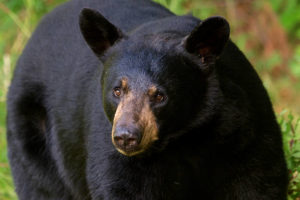
Protect livestock
Avoid pasturing animals in remote areas or nearby heavy wooded cover or travel areas that bears might use. Whenever possible, pen livestock in or near the barn at night, especially pregnant females and those with small young. Avoid field birthing if possible. Do not leave carcasses of dead animals exposed in fields, pastures, or nearby areas. Consider the use of guard animals. Keep livestock feed in secured outbuildings protected by electric fencing or in bear-proof containers.
Protect bees and chickens
Use electric fencing to safeguard hives and coops. Electric fences are most effective when put up and continuously charged before the first damage occurs. Keep open, mowed areas on all sides of hives and coops and do not locate hives or coops in abandoned areas or close to brushy, overgrown areas.
Protect crops and orchards
Temporary electric fencing may be used to protect corn and other crops. Seven-strand slanted non-electric fences have been used to keep bears out of orchards. Contact local bear hunters for the early September bear season to hunt the fields.
If you have a second home owner neighbor who has not yet arrived in the Berkshires, you might want to share the following information with them:
Bird Feeders
MassWildlife recommends that if you live in an area with bears, it is best to avoid bird feeders altogether. Bears finding a bird feeder, bird seed, corn or other bird food will often revisit that site. Bird feeders draw bears closer to people, resulting in bears losing their fear of people. This process is called habituation. It’s not safe for bears or people to be close to one another.
If you choose to put out feeders, doing so in the winter when bears are denned decreases the chances of a bear coming to your feeder. In general, most bears are denned from mid-December through February. Although most bears in Massachusetts enter winter dens, MassWildlife biologists have tracked bears that remained active for some or all of the winter if food is available. It is important that you remove the entire feeder at the first sign of bear activity.
Many wild animals are attracted to bird feeders including wild turkeys and coyotes. Since bird feeders attract small mammals like squirrels, they can also attract animals like fishers and bobcats who prey upon the smaller animals.
For those people who enjoy birds in their yards, MassWildlife suggests growing native plants, shrubs, and trees to attract birds. Adding a water feature is a big draw for birds. Taking these actions may increase the diversity of birds you see and will prevent the unnatural feeding of bears and other kinds of neighborhood wildlife. Some bears have learned to empty bird feeders without destroying the feeder. Do not continue to fill a feeder. Do not leave empty feeders out because residual smell and the sight of feeders can still attract bears.
Pets
Pet food is a tasty treat for bears so don’t leave pet food outdoors. The presence of a dog could trigger a bear to be aggressive. Keep dogs leashed and never let dogs chase or interact with bears. Check your yard for bears before letting your dog out. If you encounter a bear while with your dog, back away slowly and leave the area.
Garbage
Store all garbage in closed containers in a garage or outbuilding. Do not leave your garbage barrels outside overnight. Rather, put them by the roadside before pickup. Use of double bags or sprinkling with ammonia will help reduce odors. Bears and other wild and domestic animals will tip cans and scatter garbage. Smelly cans may attract bears even if there isn’t anything in them, so store garbage cans inside.
Compost responsibly. Do not throw meat scraps, greasy, oily or sweet materials in your compost pile. These kinds of food attract bears and other animals.
Bear-proof garbage cans may be available from municipalities or waste management contractors. In communities where bears are more common, bear-proof dumpsters are recommended for apartments, condos and campgrounds.
Clean greasy barbecues and grills after each use. Do not leave food scraps, grease containers or spilled grease in your yard.
If you see a bear in your neighborhood
A bear’s first response to something unusual is to leave. If a bear is feeding in an area where it doesn’t belong, such as your yard, on a porch, or in a dumpster, MassWildlife recommends you step outside, yell, and make lots of noise. The bear will usually leave—accompanied by its young. Habituated bears may ignore minor harassment. If you continue to see bears, check your property and remove any potential food sources.
In the Woods
Black bears are usually wary of people. Normal trail noise will alert bears to your presence and they will often disappear before you see them. If you see a bear, it may not immediately recognize you as a human and may be curious until it scents you. Make the animal aware of your presence by clapping, talking, or making other sounds while slowly backing away. Do not approach bears or intrude between a female bear and her cubs. Keep dogs leashed and stay a respectful distance away.
While Camping
MassWildlife recommends that you don’t cook, eat, or store food in or next to your tent or camp trailer where odors may linger. Sleep as far away from food storage and preparation areas as possible. Do not dispose of food scraps, grease, or other edibles in your campfire. These materials may not completely burn. Also, the scent of burned food may attract bears.
Store food in bear-proof containers or hang it high on sturdy poles or on wires strung between two trees. Food should hang at least 10 feet off the ground and 4 feet off the base of the truck. Don’t feed bears or leave food items or coolers out when away from the campsite. Use caution if storing food in your vehicle. Some bears may be able to break a window to gain entry. Even if unsuccessful, the bear’s attempts may damage your vehicle.
Store toiletries safely with your food. The scent and use of perfumes and colognes may attract bears. Stay at campgrounds that are clean, use “bear boxes” for safe food storage and dispose of garbage in bear-proof dumpsters. While hiking, normal trail noise will alert bears to your presence and prompt them to move without being noticed.
Spread the word about how to avoid conflicts with bears by sharing these tips with others.
Black bears are important and valuable mammals in Massachusetts. They are big game mammals for which regulated hunting seasons and a management program have been established.
Be River Smart!
No, I’m not referring to smart river fishing or river paddling. Heck, you don’t even have to go near a river to be river smart. The Housatonic River Association (HVA) folks are encouraging everyone to “Be River Smart!” in a different way.
According to Allison Dixon, HVA Berkshire Outreach Manager, polluted stormwater runoff is the number one threat to the water quality of our rivers and lakes today. Yet, we can all be part of the solution. Just get River Smart! Understanding the issue is the first step and then being mindful and maybe adjusting of some of our everyday behaviors is the next and most crucial step.
As Dixon points out, we all learned as kids about the water cycle – when rain falls or snow and ice melt, it either soaks into the ground or evaporates. What we probably didn’t learn is that when rain fall meets hard surfaces like roofs, paved parking lots, streets and driveways, it flows as runoff into the storm drains and asphalted channels into the nearest river or lake.
By the time it reaches that water body it is polluted stormwater runoff. Stormwater runoff picks up fluids that leak from cars such as motor oil, litter, pet waste, fertilizer, pesticides, sand and salt and more from the ground. This runoff contaminates the water raising bacteria levels and compromising the integrity of the ecosystem and the health of the aquatic life in all streams of all of our watersheds in Berkshire County.
Each one of us contributes to this source of pollution and each one of us can make a difference. Pick up that pet waste and throw it in the trash, identify and fix those vehicle leaks quickly, switch to organic lawn care and wash that car on the lawn or at a car wash.
For more information on how to be river smart, contact HVA at 413-298-7024 or email Alison Dixon, HVA’s Berkshire Outreach Manager at adixon@hvatoday.org
Trout Stockings
The following local waters were scheduled to be stocked with trout last week but, as Deb Lipa, Clerk for the Western District DFW noted, the water levels/conditions are crazy so there may have been changes and further updates after this list was prepared: Clesson Brook in Ashfield and Buckland, South River in Ashfield, Swift River in Cummington, Ashfield and Goshen; Walker Brook in Becket and Chester, West Branch Brook in Chesterfield, East Branch of the Westfield River in Cummington, Chesterfield and Huntington; Stones Brook in Goshen, West Brook in Great Barrington, Little River in Worthington and Huntington, Greenwater Brook in Lee, Goose Pond Brook in Tyringham and Lee, Beartown and West Brooks in Lee, Goose Pond in Lee, Hop Brook in Lee and Tyringham, Factory Brook in Middlefield, Konkapot River in Monterey, New Marlborough and Sheffield; Lake Buel in Monterey, Mill Brook in Plainfield, Richmond Pond in Richmond, Buck and Clam Rivers in Sandisfield, Stockbridge Bowl and Larrywaug Brook in Stockbridge, Depot Brook in Washington, West Brook in Windsor and Bronson and West Branch Brooks in Worthington.
Spring Turkey Hunting
Next Saturday, April 28, the 2018 Youth Turkey Hunt day takes place in Wildlife Management Zones 1-13. That is a special day set aside for youths aged 12 to 17. This hunt, developed through a partnership with the National Wild Turkey Federation, allows for a mentored hunt. Hopefully, the youths paid attention and successfully completed the pre-hunt workshop and received the special permits.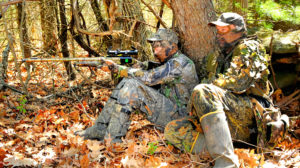
Hey youngsters, get to bed early Friday night for the spring season begins ½ hour before sunrise, which is around 5:15 am, and you should be in your hunting spot by then on Saturday morning. Good luck and have a safe and enjoyable hunt. Hopefully, the weather will be nice
Incidentally, the regular spring turkey hunting season opens on Monday, April 30 and runs through May 26.
Lenox Land Trust honors Charles Liston
The Lenox Land Trust recently informed Charles Liston of Lenox Dale that they have designated him an Emeritus Director status in recognition of his many contributions to land preservation in Lenox and Berkshire County. The emeritus letter, which was drafted by Kate McNaulty-Vaughan, Lenox Land Trust (LLT) Executive Board Member and Secretary reads as follows:
“In November, 2016 at the Lenox Land Trust Annual Meeting, the LLT awarded you a special plaque, recognizing your role in forming the Land Trust and your longstanding commitment and leadership of the conservation movement and its early initiatives in Lenox and Berkshire County.”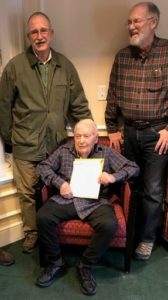
“As one of the first members of the Berkshire Natural Resources Council when it started 50 years ago, you have since distinguished yourself as one of few people who had an unbroken record of support for all 50 years! You were recognized for having been tireless in your role as a surveyor for the Commonwealth of Massachusetts, in assisting in conservation work for the state, for Lenox, and for many regional environmental groups. And for that generosity of spirit, generations to come will enjoy these preserved lands and wildlife.”
“You have explored and recorded the boundaries and features of thousands of acres of land. Your expertise and love of natural landscapes resulted in the permanent protection of many of those acres in their natural state. Always on the lookout for special lands and places in your work for the state, you identified land that would be of interest to the Berkshire Natural Resources Council, as well as the Massachusetts Division of Fisheries and Wildlife, and other conservation organizations.”
“You also served on the first Conservation Commission in the Town of Lenox and played a key role in obtaining grants for the acquisition of the Post Farm (100 acres) in 1959, and Edith Wharton Park (15 acres) in 1972 –wonderful open space and recreation lands in town. Notably, those acquisitions received 75% reimbursement from the Federal Government, and 25% from the State. When John D. Kennedy donated the southern half of Parsons Marsh to the Town in 1974, you did all the surveying free of charge, which entailed countless hours of work. This is an astounding legacy, perhaps not known to most residents today.”
“You can only be described as an avid conservationist and environmentalist. The townspeople and Lenox Land Trust will be forever grateful to you for all these unselfish gifts of your time, expertise, and land, especially that parcel on Crystal Street (Lenox Dale) donated for a small park in 2007. In 2008 the Town of Lenox dedicated that lovely spot as Liston Park to honor you and your late wife Carmen.”
May I also add that anyone who has hunted the Post Farm, the George Darey Wildlife Management Area or Hallowell Meadow; or hiked or bird watched at the Edith Wharton Park or Parson’s Marsh in Lenox owes Charlie a great deal of gratitude.
We also owe the 95 year-old veteran our heartfelt gratitude for serving in the US Marines during WWII in the South Pacific, notably in the Saipan, Tinian and Okinawa campaigns.
Trout stocking
The following waters were scheduled to be stocked with trout last week: Hoosic River (South Branch) in Adams and Cheshire; Hoosic River (North Branch) in Clarksburg; Deerfield River in Buckland, Charlemont and Florida; Chickley River in Charlemont, Hawley and Savoy; Cold River in Charlemont, Florida and Savoy; Westfield River in Chester, Huntington, Middlefield and Worthington; Housatonic River (C&R) in Lee and Stockbridge, Housatonic River in Hinsdale and Dalton, Housatonic River (Southwest Branch) in Pittsfield, Littleville Reservoir in Chester and Huntington, Hudson Brook in Clarksburg, Town Brook in Lanesboro, Goose Pond in Tyringham and Lee; Garfield Lake in Monterey, Onota Lake in Pittsfield, Green River and Hemlock Brook in Williamstown.
Land Acquisition
In his April report to the Berkshire County League of Sportsmen, DFW Western District Supervisor Andrew Madden reported that MassWildlife recently acquired 52 acres off land off of Tannery Road in Otis, MA. The primary feature of the property is approximately 1,500 feet of frontage along the Farmington River. It is accessible from Tannery Road near where the Knox Trail Rider’s and the Isaac Walton League Clubhouse is. DFW also picked up a one-acre piece of land along that road for a parking area and access to the river.
Earth Week Stocking Event
MassWildlife invites you to celebrate Earth Week by helping them stock trout on Richmond Pond. You will have the opportunity to meet MassWildlife fisheries staff, view trout up close, and learn about places to fish near you. The event takes place on Thursday, April 19, at 1:30 pm. at the Richmond Pond Boat Ramp off of Town Beach Road.
Quadriplegic hunter
Say, remember Zach Porio? He was the quadriplegic turkey hunter that I wrote about in August entitled “Local turkey hunter is an inspiration to us all”. (August 13, 2017) To refresh your memory, he is the guy that shot a turkey using his knees as support and pulling the trigger with both hands. After dropping a tom, he had to drive his truck closer to the bird, grab a rope, get into his wheelchair and push it 20 yards over a meadow to retrieve it. He then had to bend over, tie the turkey by its feet, push himself back upright into the wheelchair, put the rope into his mouth and drag the 12 lbs turkey back to his truck while pushing the wheelchair.
Well, the local community rallied to the aid of the young man who was paralyzed from the chest down in a dirt bike accident several years ago. The plan was to get the avid hunter a special chair which would allow him to be more mobile in the woods.
Through fund raising dinners, auctions, collection boxes and various events, the community and businesses got together to raise enough funds to enable Zach to purchase that special chair. Quite a different chair than the wheelchair that was featured in this column back in August, hey?
This is what Zach posted on Facebook, “I just want to thank everyone so incredibly much for their generosity in helping me to get this incredible chair. I can’t tell you how amazing it was to interact and get out there to play in the snow with everyone again, instead of watching from the sidelines. To be able to move around on my own with almost no limitations and to stand more than I’ve done in a long while was great and just what I needed to cure the cabin fever of winter. Being outdoors is something that I used to enjoy so much in the past but have dreaded ever since the accident. Now, this chair gives me the ultimate freedom to get around and maneuver the outdoors like I used to love so much.”
“I thank you all for coming together to make such a huge difference in my life and giving me the ability to interact with my children beyond the limitations of my wheelchair. Again, I’m just beyond amazed at our community and the phenomenal things that are accomplished when people come together. I want to let you know that the sharing won’t stop and that I plan to give others in the community the opportunity to experience a bit of the joy and freedom by extending the offer for others with accessibility limitations the chance to utilize the track chair. Thank you again, Zack.”
Acid Rain Monitors are now even more important
If you saw a grown adult poking around in your little neighborhood stream last Sunday, you needn’t have been alarmed. Its possible that the person was one of the half dozen local Acid Rain Monitors collecting water samples for UMASS. Through fair or foul weather, they have been monitoring Commonwealth waters for over 30 years now. Last Sunday, they were collecting water samples in 20-degree weather. But they are a dedicated lot and most of them have been doing these annual samples, never missing a collection date, for 15-20 years now.
The monitors knew that the water samples collected in our area were brought to Westfield State University to be tested for ph, alkalinity, major cations and anions. But recently, they were informed by UMASS that this year the samples will be used as part of Dr. Boutt’s Isoscape project, which involves mapping the distribution of hydrogen and oxygen isotopes in surface waters throughout Massachusetts.
Dr. David F. Boutt is an Associate Professor of hydrogeology, watershed hydrology and groundwater recharge/discharge with the Department of Geosciences UMASS-Amherst. The goal of this project is to develop a baseline of environmental isotopes to understand hydrologic functioning of surface and ground waters throughout the Commonwealth. The ultimate product of this effort are spatial maps of isotopic composition of surface water and groundwater that will define the isoscape in which we live.
Through a combination of sampling efforts by numerous voluntary contributing organizations and the UMASS Hydro Team, they have been able to create a water isotope database consisting of data from all over Massachusetts and much of the Northeast.
Depending on the weight of the water, the source of the water (extra-tropical versus arctic) or the age of the water (recently precipitated versus groundwater) can be inferred. For example, extra-tropical storm waters tend to have a heavier signature whereas Arctic waters tend to be slightly lighter. Precipitation is usually significantly heavier than older water.
So why is this research important? According to UMASS, most significantly, the breadth of this project allows them to track the response of watersheds to hydrologic events–whether that be major storms, or droughts. This will especially be significant as climate change begins to take effect and more extreme weather events occur. Water isotope signatures are also useful in other environmental scenarios such as a tracer in contamination scenarios. This project is the first of its kind at the state level in the nation.
Who would have thought that our collectors with their white bottles of water could turn out to be so important in the scheme of things? Most of the collectors are fishermen and women who have a love for and a desire to protect our waters. Also, who would have thought that your little stream in Becket, Sheffield or Richmond would be part of such an important and far reaching study?
For more information about the project, and a definition of isotopes, click onto: https://blogs.umass.edu/dboutt/research/current-research/isoscape-project/
Freshwater Fishing Gold Pin winners are announced
Each year, MassWildlife recognizes anglers who catch exceptional freshwater fish in waters open to the public. If you submit the largest or longest fish in an eligible species category, you will get a gold pin and a plaque, and you’ll also be honored in a MassWildlife awards event.
Log onto https://www.mass.gov/service-details/gold-pin-winners to see all of the 2017 winners in the Adult Catch & Keep, Youth Catch & Keep and Catch & Release categories. You will notice that there were 6 gold pins awarded to local anglers or fish caught out of local waters.
In a ceremony held at the MassWildlife Field Headquarters in Westborough, MA on Saturday, March 17, the lucky anglers received gold pins and plaques commemorating their great feats.
Winners from our area were as follows:
Adult catch & keep category: Brook Trout, 3 lbs, caught out of Laurel Lake by Andrew Bostwick of North Adams; Northern Pike, 29 lbs 10 oz, caught out of Cheshire Reservoir by Kevin Janis of Pittsfield.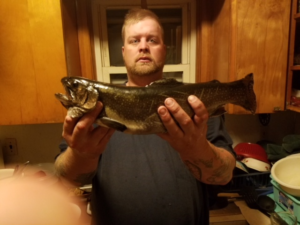
Youth catch & keep category: Chain Pickerel,4 lbs 11 oz, caught out of Lake Buel in Monterey by Mario Daniele of Wilbraham, MA; Crappie, 2 lbs, caught out of Onota Lake by Caedin Ostellino of Lanesborough.
Catch & release gold pin winners: Brook Trout, 19 inches, caught out of Lake Buel by Nicholas Hutline of Granville, MA; Northern Pike, 45.50 inches caught out of Onota Lake by Ashley DePaoli of Stamford, VT.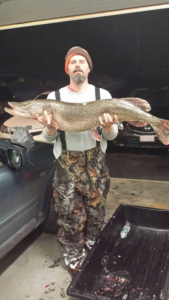
2017 Angler of the Year award winners
The Catch & Keep Angler of the Year Award is given to the person who weighs in the largest number of species that meet the minimum weight requirements for the previous calendar year. The award promotes awareness of the Commonwealth’s underutilized fish species and recognizes an angler’s ability to catch a wide variety of trophy species.
The Catch & Release Angler of the Year Award is awarded to the person who submits the largest number of species that meet the minimum length requirements for the previous calendar year.
This year the winners were:
Adult Catch & Keep Category: Mark Mohan, Jr. of Pembroke, MA. Mohan received State pins for the following species of fish: Bowfin, Brown Trout, Carp, Chain Pickerel, Crappie, Lake Trout, Northern Pike, Shad, Sunfish, Walleye, White Catfish and Yellow Perch. He also won the Adult Catch & Keep title in 2015, 2014 and 2013.
Youth Catch & Keep Category: Jason Bunar of Kingston, MA. He received State pins for the following fish species: Bowfin, Brook Trout, Brown Trout, Bullhead, Carp, Chain Pickerel, Channel Catfish, Crappie, Lake Trout, Landlocked Salmon, Largemouth Bass, Northern Pike, Rainbow Trout, Shad, Smallmouth Bass, Sunfish, Tiger Trout, Walleye, White Catfish, White Perch and Yellow Perch. He also won that title in 2016.
Catch & Release Angler Category: Michael Nee of Northborough, MA. Michael received state pins for the following species of fish: Bowfin, Brook Trout, Brown Trout, Bullhead, Carp, Chain Pickerel, Channel Catfish, Crappie, Lake Trout, Landlocked Salmon, Largemouth Bass, Northern Pike, Rainbow Trout, Shad, Smallmouth Bass, Sunfish, Tiger Trout, Walleye, White Catfish, White Perch and Yellow Perch. He also won that title in 2016 and 2015.
These anglers are amazing! They just didn’t catch the above species of fish, but the fish had to be of sizes to earn at least bronze pins. For example, for a largemouth bass to qualify, it had to be at least 7 lbs in the adult catch & keep category, at least 4 lbs in the youth category and at least 21 inches in the Catch & Release. Most anglers that I know are lucky to have caught a couple of pin fish in their entire lifetimes!
New State record fish caught in 2017 were as follows:
Catch & Keep Category:
Bowfin: 8 lbs, 1 oz caught out of the Taunton River in Taunton by David Souza of Berkley, MA. Two days later, his son Jake Souza also caught a fish of identical size and tied the record. (Those catches were featured in this column of September 3, 2017, “State record bowfin caught …TWICE”)
Catch & Release Category:
Bowfin: 29.50 inches out of Taunton River by Michael Nee of Northborough.
Brook Trout: 19 inches caught out of Lake Buel, Monterey by Nicholas Hutline of Granville, MA. Also, a same sized brookie was caught out of Fort Pond in Lancaster, MA by Ryan Gorman of Leominster, MA.
Channel Catfish: 31 inches caught out of the Connecticut River in Agawam, MA by Paul Beauchesne, Jr. of Worcester, MA.
Crappie: 17.25 inches caught out of the Connecticut River in Greenfield by Jeff Magnan of Gardner, MA.
Largemouth Bass: Two 25-inch fish, both caught out of Mashpee-Wateby Pond, Mashpee, one by John Gonsalves of Norton, MA and the other caught by Dylan Towne of West Wareham, MA.
Northern Pike: 45.50 inches caught out of Onota Lake in Pittsfield by Ashley DePaoli of Stamford, VT.
Shad: 25.25 inches caught out of the Chicopee River in Granby, MA by Paul Beauchesne, Jr. of Worcester, MA.
Smallmouth Bass: 22.50 inches caught out of Wachusett Reservoir by Marc Mahoney of Shrewsbury, MA.
Walleye: 28 inches caught out of the Connecticut River in Turners Falls by Mark Mohan, Jr. of Pembroke, MA.
White Perch: 17.25 inches caught out of Wachusett Reservoir by Prince Dukuly of West Boylston, MA.
A hearty, hearty congratulations to all!
A talk on the Deerfield River
This Wednesday evening, at the Berkshire Hills Country Club, 500 Benedict Rd., Pittsfield, the Taconic Chapter of Trout Unlimited will be having Michael Vito, Vice-President of the Deerfield River Chapter TU as its guest speaker. Mike’s presentation will be on the ongoing Deerfield River Wild Brown Trout Spawning Study.
If you are not familiar with that study, last November the group claims to have found over 90 redds on the Deerfield River below Fife Brook Dam. Many skeptics had previously proclaimed that these wild trout were coming from the tributaries and not from the main stem of the Deerfield. Well, apparently this group has proven them wrong. This might be worthwhile to stop in to hear what Mike has to say.
There will be a social hour starting at 5:30 PM followed by Mike’s presentation. (There will be no meal as the kitchen is closed this time of year). The presentation is free and open to the public. Contact Taconic TU President Henry Sweren at (413)822-5216 for more information.
Protecting our critters
In the 1950s, the pesticide DDT eliminated peregrine falcons from Massachusetts. In 1984, the MA Natural Heritage & Endangered Species Program (NHESP) began releasing young peregrines to restore the population. By 1987, the first successful pair nested on the Custom House Tower in Boston. Today, NHESP monitors nests, bands chicks, and improves nesting success with nest boxes. Over the past 31 years since their restoration, at least 646 wild-born chicks are known to have fledged in Massachusetts. You can support NHESP and efforts like this to help rare species by donating on Line 33A of your MA State Tax return. ( mass.gov/nhesp)
The List of Endangered, Threatened, and Special Concern species totals 427 native plant and animal species and are protected under the Massachusetts Endangered Species Act (MESA). They include 14 mammals, 27 birds, 15 reptiles, 4 amphibians, 10 fish, 99 non-marine invertebrates and 258 plants.
All money donated to the Endangered Species Program on the State tax return, goes into a dedicated fund. Money from this dedicated fund can only be used by the NHESP, which focuses its work on our state’s rare species. You can learn more about this program here: https://www.mass.gov/…/masswildlifes-natural-heritag.
Bill to Advance Hunter Recruitment and Retention
Recently, The Boone and Crockett Club extended its full support of a new House bill that seeks to advance hunter recruitment and retention. The Modernizing Pittman-Robertson Fund for Tomorrow’s Needs Act of 2017 (H.R. 2591) will provide technical and financial assistance to states for promoting hunting and recreational shooting.
The bill, introduced by Georgian Congressman Austin Scott (GA-08) would allow state fish and wildlife agencies the flexibility they need to address the declining number of hunters by using existing funds from the Pittman-Robertson Wildlife Restoration Fund to increase hunting and recreational shooting opportunities. The bill will also serve to clarify that one of the purposes of these funds is to provide financial and technical assistance to the states for hunter recruitment and retention, hunter education programs, and education programs to the non-hunting public.
“When the Boone and Crockett Club helped draft and get the Pittman-Robertson Act passed by Congress in 1934, we had lots of hunters and game populations were still recovering,” said Ben B. Hollingsworth Jr., president of the Boone and Crockett Club. “Today, game is abundant once again, but declining hunter participation means declining funds. This bill is the right thing to do at the right time to ensure healthy wildlife and ecosystems into the future.”
The Pittman-Robertson Act charges sportsmen an excise tax on the purchase of sporting arms and ammunition. These funds are distributed annually to state fish and wildlife agencies for wildlife and habitat conservation programs. Plans for what to do with the money must be submitted to and approved by the Secretary of the Interior. Acceptable options to date include research, surveys, management of wildlife and/or habitat, and acquisition or lease of land. Once a plan has been approved, the state must pay the full cost and is later reimbursed for up to 75 percent of that cost through P-R funds. The 25 percent of the cost that the state must pay generally comes from its hunting license sales. As of 2010, more than two billion in P-R dollars have been collected and distributed to states.
“In its day, Pittman-Robertson addressed the challenges of funding critical conservation work,” Hollingsworth Jr. explained. “The challenge of today is keeping these funds coming. Without sportsmen and new hunters coming in, the challenge will be greater.”
Conservation funding is based on a user-pay, public-benefit model. Those who value and use the resource pay for its care.
“Sportsmen have taken the responsibility of footing the bill for wildlife and the habitats they depend upon for everyone’s benefit,” Hollingsworth Jr. concluded. “Choosing to tax themselves in the midst of the Great Depression should tell you something about the character and commitments of hunters.”
